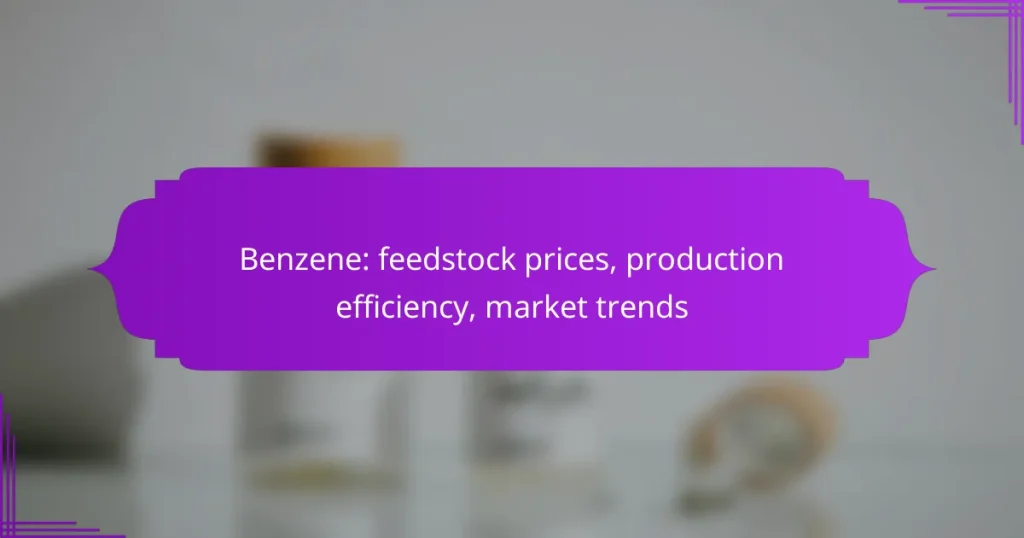As of late 2023, benzene feedstock prices in New Zealand range from NZD 1,200 to NZD 1,500 per tonne, influenced by market dynamics such as demand and production costs. The production of benzene has become increasingly efficient through optimized processes that reduce waste and energy consumption. Current market trends indicate fluctuations driven by regional demand variations, regulatory impacts, and the development of new applications that are transforming the industry landscape.

What are the current benzene feedstock prices in New Zealand?
As of late 2023, benzene feedstock prices in New Zealand typically range from NZD 1,200 to NZD 1,500 per tonne. These prices fluctuate based on various market dynamics, including demand and production costs.
Current market price trends
The market for benzene in New Zealand has shown a moderate increase over the past year, driven by rising demand in the petrochemical sector. Prices have been particularly influenced by global supply chain disruptions and local production capabilities.
Recent trends indicate that prices may stabilize or experience slight fluctuations in the coming months, depending on seasonal demand and international market conditions.
Factors influencing feedstock prices
Several factors impact benzene feedstock prices, including crude oil prices, production costs, and regulatory changes. As crude oil prices rise, the cost of benzene production typically follows suit, leading to higher feedstock prices.
Additionally, local production efficiency and capacity can affect supply levels. If production facilities face downtime or maintenance issues, this can create shortages and drive prices up.
Comparison with global prices
When compared to global prices, New Zealand’s benzene feedstock prices are generally in line with trends observed in other regions, such as Asia and North America. However, local market conditions and transportation costs can create variances.
For instance, while global prices might hover around USD 1,000 to USD 1,300 per tonne, New Zealand’s prices reflect additional logistical expenses, making them slightly higher. Monitoring international benchmarks can provide valuable insights for local buyers and sellers.

How is benzene produced efficiently?
Benzene is produced efficiently through optimized processes that minimize waste and energy consumption while maximizing yield. Key factors include selecting the right production method, monitoring efficiency metrics, and adopting the latest technological advancements.
Common production methods
The most common methods for producing benzene include catalytic reforming, steam cracking, and toluene hydrodealkylation. Catalytic reforming converts naphtha into benzene using catalysts and heat, while steam cracking breaks down hydrocarbons at high temperatures. Toluene hydrodealkylation involves the conversion of toluene into benzene, often yielding higher purity levels.
Each method has its advantages and trade-offs. For instance, catalytic reforming is widely used due to its efficiency, but it requires significant energy input. Steam cracking, on the other hand, can produce a variety of byproducts, which may complicate processing.
Efficiency metrics in production
Efficiency metrics in benzene production typically focus on yield, energy consumption, and cost-effectiveness. Yield refers to the amount of benzene produced relative to the feedstock used, while energy consumption measures the energy required for production. Cost-effectiveness evaluates the overall expenses, including raw materials and operational costs.
Producers often aim for yields above 90% and energy consumption in the low tens of megajoules per kilogram of benzene. Monitoring these metrics helps identify areas for improvement and optimize production processes.
Technological advancements
Recent technological advancements have significantly enhanced benzene production efficiency. Innovations such as advanced catalysts and process optimization software allow for better control over reactions and improved yields. Additionally, the integration of real-time monitoring systems helps in adjusting parameters dynamically to maintain optimal conditions.
Investing in these technologies can lead to substantial cost savings and reduced environmental impact. Producers should consider adopting such advancements to remain competitive in the evolving market landscape.

What are the market trends for benzene in 2023?
In 2023, the benzene market is experiencing fluctuations driven by varying demand and production efficiencies. Key trends include increased demand in specific regions, regulatory impacts, and the emergence of new applications that are reshaping the market landscape.
Demand forecasts in New Zealand
Demand for benzene in New Zealand is expected to grow moderately as industries such as automotive and construction expand. The local market is influenced by global trends, with an emphasis on sustainable practices driving the need for alternative materials that still utilize benzene derivatives.
Manufacturers in New Zealand are adapting to these changes by optimizing production processes and exploring partnerships to secure stable supply chains. This adaptation is crucial for meeting the anticipated demand while maintaining cost-effectiveness.
Impact of regulations on the market
Regulatory frameworks are significantly shaping the benzene market, particularly concerning environmental standards and safety guidelines. Stricter regulations on emissions and chemical handling are prompting companies to invest in cleaner technologies and processes.
Compliance with these regulations can lead to increased operational costs, but it also opens opportunities for innovation and efficiency improvements. Companies that proactively adapt to these changes are likely to gain a competitive edge in the market.
Emerging applications of benzene
New applications for benzene are emerging, particularly in the production of advanced materials and pharmaceuticals. The rise of electric vehicles is also creating demand for benzene-based components in batteries and lightweight materials.
As industries evolve, the versatility of benzene continues to be leveraged, leading to innovative uses that may not have been previously considered. Staying informed about these developments can help businesses identify new market opportunities and adjust their strategies accordingly.

What are the key players in the benzene market?
The benzene market features several key players, including major producers and global competitors that influence pricing and production efficiency. Understanding these entities is crucial for navigating market trends and making informed decisions in the industry.
Major producers in New Zealand
In New Zealand, the benzene production landscape is relatively small, with a few key players dominating the market. Companies like Z Energy and Refining NZ are significant contributors, primarily producing benzene as a byproduct of refining crude oil.
The local market is influenced by regional demand for petrochemicals, which can fluctuate based on economic conditions. Producers often focus on optimizing their refining processes to enhance efficiency and reduce costs.
Global competitors
Globally, the benzene market is competitive, with major players including companies like ExxonMobil, BASF, and Shell. These corporations operate large-scale facilities that benefit from economies of scale, allowing them to produce benzene at lower costs compared to smaller producers.
Market dynamics are affected by factors such as crude oil prices, environmental regulations, and shifts in demand for downstream products like plastics and synthetic fibers. Understanding these global competitors is essential for local producers to strategize effectively in pricing and production.

What criteria should be considered when selecting benzene suppliers?
When selecting benzene suppliers, consider factors such as quality standards, pricing structures, and delivery logistics. These criteria will help ensure you receive a reliable product that meets your operational needs and budget constraints.
Quality and compliance standards
Quality and compliance are critical when choosing benzene suppliers. Look for suppliers who adhere to industry standards such as ASTM D1152 or ISO 9001, which ensure product consistency and safety. Verify that the supplier can provide documentation proving compliance with local regulations and safety guidelines.
Additionally, assess the supplier’s quality control processes. Regular testing and certification from recognized laboratories can indicate a commitment to maintaining high-quality benzene. This is particularly important in regions with stringent environmental regulations.
Pricing structures
Understanding the pricing structures of benzene suppliers is essential for budgeting. Prices can vary based on market trends, supplier contracts, and delivery terms. It’s advisable to request quotes from multiple suppliers to compare costs effectively.
Consider whether the pricing is fixed or variable, as this can impact long-term contracts. Some suppliers may offer discounts for bulk purchases or long-term agreements, which can lead to significant savings over time.
Delivery and logistics options
Delivery and logistics are vital components of the benzene supply chain. Evaluate the supplier’s ability to meet your delivery schedules and their logistics capabilities, including transportation methods and storage options. Timely delivery is crucial to avoid production delays.
Additionally, inquire about the supplier’s geographic reach. Suppliers with local distribution centers may offer faster delivery times and lower shipping costs. Understanding their logistics network can help you make an informed decision that aligns with your operational needs.

How does benzene production impact the environment?
Benzene production significantly impacts the environment through emissions and waste generation, contributing to air and water pollution. The processes involved can release volatile organic compounds and other harmful substances, necessitating careful management to mitigate these effects.
Environmental regulations
Environmental regulations play a crucial role in controlling the impact of benzene production. In many countries, strict guidelines limit emissions of hazardous air pollutants and require regular monitoring of production facilities. Compliance with standards such as the Clean Air Act in the United States or the REACH regulation in the European Union is essential for minimizing environmental harm.
Fines for non-compliance can be substantial, often reaching millions of dollars, which incentivizes companies to adopt cleaner technologies and practices. Additionally, regulations may mandate the use of specific pollution control technologies, such as scrubbers or filters, to reduce harmful emissions.
Sustainability practices
Implementing sustainability practices in benzene production can significantly reduce its environmental footprint. Companies are increasingly adopting circular economy principles, focusing on resource efficiency and waste reduction. For example, recycling solvents and utilizing by-products can minimize waste and enhance overall production efficiency.
Investing in cleaner production technologies, such as advanced catalytic processes, can also lower emissions and energy consumption. Companies should regularly assess their operations for opportunities to improve sustainability, such as optimizing energy use or transitioning to renewable energy sources.

What are the future trends in benzene production and usage?
Future trends in benzene production and usage indicate a shift towards more sustainable practices and increased efficiency. As environmental regulations tighten and demand for eco-friendly products rises, the industry is likely to adopt innovative technologies and alternative feedstocks.
Feedstock Prices
Feedstock prices for benzene production are influenced by crude oil prices, natural gas availability, and market demand. Fluctuations in these commodities can lead to significant variations in production costs. For instance, when crude oil prices rise, benzene feedstock costs typically follow suit, impacting overall market pricing.
Producers need to stay informed about global oil market trends and consider hedging strategies to manage price volatility. Monitoring supply chain disruptions can also provide insights into potential cost increases.
Production Efficiency
Improving production efficiency in benzene manufacturing involves optimizing processes and reducing waste. Technologies such as catalytic reforming and steam cracking are commonly used to enhance yield and minimize energy consumption. Implementing these methods can lead to lower operational costs and a reduced carbon footprint.
Companies should regularly assess their production methods and invest in upgrades that align with sustainability goals. This may include adopting advanced monitoring systems to track performance and identify areas for improvement.
Market Trends
Market trends for benzene indicate a growing demand in various sectors, including automotive, construction, and consumer goods. The rise of electric vehicles and sustainable materials is reshaping the landscape, prompting manufacturers to innovate and diversify their product offerings.
Staying ahead of market trends requires companies to engage in continuous research and development. Collaborating with stakeholders and investing in new technologies can help businesses adapt to changing consumer preferences and regulatory pressures.


